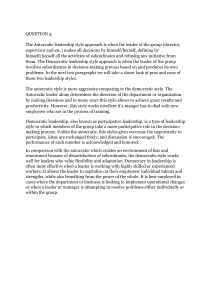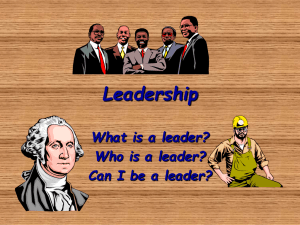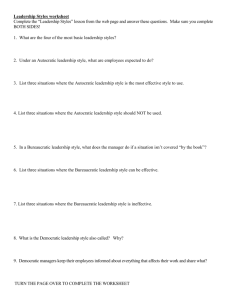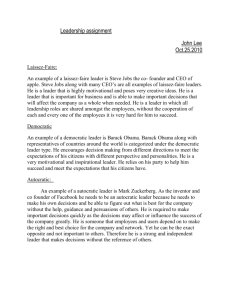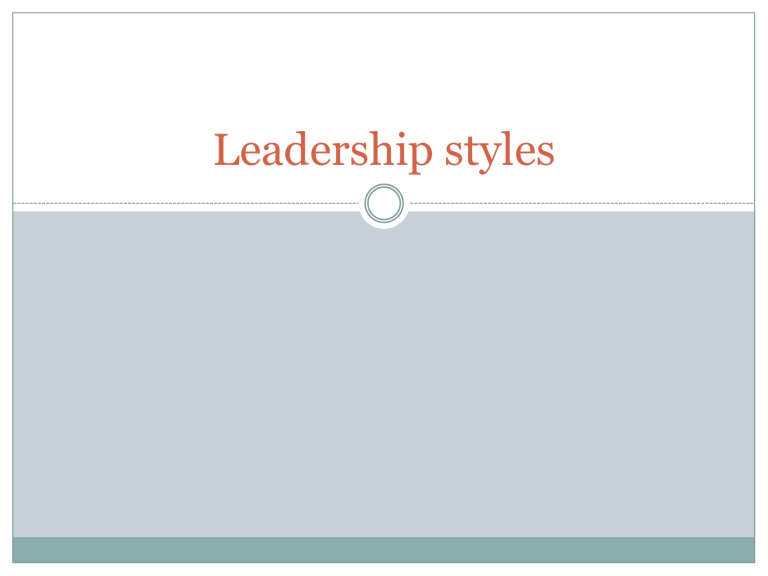
Leadership styles Leadership & management Leadership Management The act of establishing direction, purpose and the necessary capabilities among a group of people Organising human and physical resources to achieve business aims and objectives Leaders have certain qualities such as: •Vision •The ability to influence others Managers perform a range of functions such as: •Setting objectives •Co-ordinating activities •Reviewing performance According to Peter Drucker: ‘Management is doing things right; leadership is doing the right things.’ Learning Outcome ● Compare and contrast the following leadership styles (AO3): ○ autocratic ○ paternalistic ○ democratic ○ laissez-faire ○ situational Leadership Styles ● Refers to the ways in which decision makers behave or reveal their behaviour. ● There are five common styles of leadership: ○ autocratic ○ paternalistic ○ democratic ○ laissez-faire ○ situational Source: http://www.justscience.in/wp-content/uploads/2018/03/how-do-traditionalleadership-styles-vary-between-america-and-asian-countries-837x500.jpg Leadership Styles ● Autocratic: ● Domineering and possibly tyrannical approach ● Strong and rule-oriented ● Paternalistic: ● Looks after the organization's interests and its employees as if they were family ● Democratic: ● The opposite of autocratic ● Values inclusiveness and employees' input ● Laissez-faire: ● French meaning ‘let do’ or ‘hands-off’ ● A lack of interference from the leader of an organization ● Situational: ● A style that one adopts for a particular situation Leadership Styles Warren Bennis: ● Leaders find their own style that suits them best. ● Effective managers and leaders will not use a single style (different situations require them to adapt). ● This will depend on several factors such as: ○ The traits, personality, and experiences of the manager or leader ○ The level of skills, experience, motivation, and confidence of employees ○ The time frame (how quickly decisions need to be made) ○ The task (ex. whether the task is routine or a crisis) ○ The degree of importance of the decision (ex. tactical or strategic decision-making) Autocratic (authoritarian) Features of autocratic management: •The manager retains control and takes all the decisions (Decision making is carried out by and individual or selected few individuals) •There is little consultation with workers •Subordinates are expected to obey instructions •Only one way communication ( Top- down) •Workers only given limited information about the business Benefits: Drawbacks: •Autocratic management allows quick decisions to be made •Often necessary during crisis situations •Can ensure that the direction of the organisation remains in line with organisational objectives •Workers may become dependent on the managers •Little creativity is encouraged •Employees may not be given the opportunity to express their ideas •Decisions do not benefit from employee input •May lead to workers feeling ignored or demotivated Autocratic Autocratic Source: Kognity, 2.3.3 Paternalistic Features of paternalistic management: •Similar to autocratic management but the leader makes decisions based on the best interests of the workers •Managers take most of the responsibility for decision making although there may be some consultation with workers •Some feedback and consultation encouraged – but not participative decision - making Benefits: Drawbacks: •Employees feel valued •The workers may be persuaded that the decisions made are in their best interests •Little scope for employees to make decisions •There is still a ‘them and us’ culture with paternalistic management •Low staff motivation if loyal connection to leader is not established Source: Kognity, 2.3.3 Paternalistic Paternalistic Democratic Features of democratic management: •Employees are encouraged to participate in and influence decision making •Information is shared with team members to allow full staff involvement •A single-status culture is encouraged •Two-way communication used, which allows feedback from staff Benefits: Drawbacks: •Democratic management can gain commitment, especially during periods of change •Employees are more likely to buy into decisions •Motivation may improve •Decision making can become slower, on occasions quick decision making will be required •Level of involvement, some issues might be too sensitive or too secret •Consultation with staff can be time-consuming Democratic Source: Kognity, 2.3.3 Democratic Laissez-faire Features of laissez-faire management: •Little direction is given to the workers •Broad guidelines may be provided but the day-to-day influence of managers is limited •Subordinates are free to make decisions Benefits: Drawbacks: •Useful for skilled, creative and well-trained employees •Can motivate workers as they have more control over their working lives •Decision-making can become very time-consuming and may lack direction, this could lead to a loss of security •May lead to chaos if good teamwork, feedback and working relationships are not evident, may be demotivating Laissez Faire Laissezfaire Source: Kognity, 2.3.3 Situational Features of Situational Style: •The style of leadership used will depend on the nature of the task and the work group’s skills •Right leadership style for the right situation •CLOTS: Factors that can affect situational leadership styles: Culture, Leader, Organizational Structure, Task, Subordinates Benefits: Drawbacks: •Flexibility •Varying the style of leadership may be difficult for some workers •They may be uncertain of how they will be led in different situations In Summary The style of leadership will likely be influenced by: ● The subordinates o Subordinates’ skills, age, education, expectations, and motivation ● The decision o Whether urgent, important, or consequential ● The leader o The leader’s character, values, experience, and expectations ● The environment o Whether creative, standardized, repressive, democratic, or compliant Situational Source: Kognity, 2.3.3 Style versatility Effective managers may have to adapt their management style to the changing situations in which they find themselves E.g. a usually democratic manager may need to use an autocratic management style during a crisis situation Exam tip Avoid writing subjective comments when commenting on leadership styles like laissez faire is good and autocratic is bad. Sometimes autocratic leadership is better than laissez faire, for example during a crisis or with imminent deadlines. When answering a question based on 'the best' or 'most appropriate' style of leadership, remember that this will depend on The nature of the task being performed The importance of the task The skills and experiences of the workers being led The organizational culture Tip 2 • • • • • The factors that affect the choice of leadership style is the acronym TWICE: Task –the nature of the task at hand, Workers – The skills, qualifications, confidence, experience and abilities of the workforce Individual – The individual leader will have his/her own personality and preferences, Culture – Organizational culture also determines the leadership style used, Experiences – Leaders will have gained experience in handling different situations and circumstances. What leadership Style? 1. A business major is leading a team of research scientist working on new ways to use plastic. Although the team discusses the merits of each ideal and project, she retains the final decision making authority. 2. A new supervisor has just been put in charge of the production line. He immediately starts by telling the crew what changes need to be made. When some suggestions are made, he tells them he does not have time to consider them. 3. A construction crew has worked together for the last four years with very little change-over in personnel. They always vote whenever a decision has to be made on how to proceed with the project. What leadership Style? 4. The owner of a small electronic store starts every day by telling the three employees what has to be done and how to do it. 5. An inspection line has no supervisor. They are expected to have the correct staffing, procedures, and expertise on each shift to ensure no defective parts gets pass them. 6. A new squad leader is just assigned overseas. She immediately calls her squad together for a meeting and asks for their ideas and input on an upcoming field training exercise. 7. There are seven people on a special project team and each individual is from a different department. Although a leader was elected, for a decision to pass it must have the approval of each individual. What leadership Style? 8. A small department performs the same functions every day. To get information out, the supervisor sends it by email or voice mail, very rarely is a meeting called. 9. A forklift has its forks raised in the air to put some material in the racks. An employee darts under the forks (safety violation) so he can get back to his workstation in time. The supervisor tells him very sternly not to ever do that again and notes it in his log. 10. A project is running late. The manager puts out a course of action to take to try to put it back on track. Later that week she calls a meeting of all supervisors and key players to create a strategy to keep the project running on schedule. What leadership Style? 11. A manager is working on the budget. He is told to get a hot project running immediately. He calls his staff together and explains the project. He then tells them to get it up and going while he completes the budget. 12. A newly hired supervisor is not allowed to make any decisions unless it is approved by the manager first. Leadership Styles - Roleplay Scenario: You work for Fony, Thailand’s largest supplier of DVDs. Your company owns a factory where you produce and package DVDs under licence for the large Hollywood film studios. Instructions: For each of the situations, your group will use one of the leadership styles studied and act out how you would react to the problem (one of your group members should play the manager, the rest should be employees). Think about how the employees would react to the manager.

